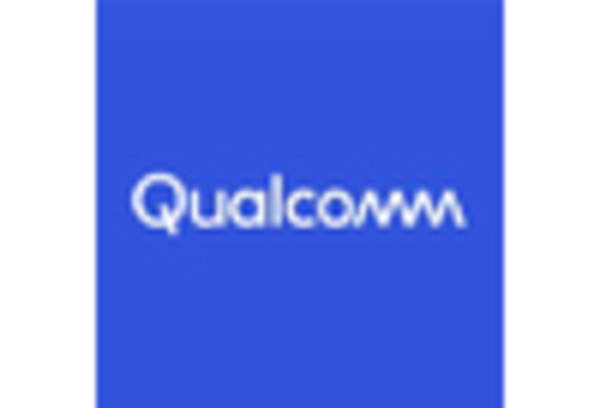The optical fingerprint-sensor market is currently characterized by intense competition and rapid technological advancements. Key growth drivers include the increasing demand for biometric security solutions across various sectors, such as consumer electronics, automotive, and financial services. Major players like Synaptics (US), Qualcomm (US), and Apple (US) are strategically positioned to leverage their technological expertise and extensive R&D capabilities. Synaptics (US) focuses on innovation in sensor technology, while Qualcomm (US) emphasizes partnerships to enhance its product offerings. Apple (US), on the other hand, continues to integrate advanced biometric solutions into its devices, thereby reinforcing its market leadership. Collectively, these strategies contribute to a dynamic competitive environment, where innovation and strategic partnerships are paramount.
In terms of business tactics, companies are increasingly localizing manufacturing and optimizing supply chains to enhance efficiency and reduce costs. The market structure appears moderately fragmented, with several players vying for market share. However, the influence of key players is substantial, as they set industry standards and drive technological advancements. This competitive structure fosters an environment where smaller firms must innovate rapidly to keep pace with the larger entities.
In October 2025, Synaptics (US) announced a partnership with a leading smartphone manufacturer to develop next-generation optical fingerprint sensors. This collaboration is expected to enhance the security features of mobile devices, thereby positioning Synaptics (US) as a frontrunner in the biometric technology space. The strategic importance of this partnership lies in its potential to expand Synaptics' (US) market reach and solidify its reputation for cutting-edge technology.
In September 2025, Qualcomm (US) unveiled its latest optical fingerprint sensor technology, which boasts improved accuracy and speed. This development is particularly significant as it addresses consumer demands for seamless user experiences in mobile devices. By prioritizing innovation, Qualcomm (US) aims to differentiate itself in a crowded market, potentially increasing its market share and reinforcing its competitive edge.
In August 2025, Apple (US) integrated advanced optical fingerprint sensors into its latest product line, enhancing security and user convenience. This move not only strengthens Apple's (US) product offerings but also underscores its commitment to maintaining a competitive advantage through technological innovation. The strategic importance of this integration lies in its ability to attract consumers seeking enhanced security features in their devices.
As of November 2025, current competitive trends in the optical fingerprint-sensor market include a strong emphasis on digitalization, sustainability, and AI integration. Strategic alliances are increasingly shaping the landscape, as companies recognize the value of collaboration in driving innovation. Looking ahead, competitive differentiation is likely to evolve, with a shift from price-based competition to a focus on innovation, technology, and supply chain reliability. This transition suggests that companies that prioritize R&D and strategic partnerships will be better positioned to thrive in the evolving market.
















Leave a Comment